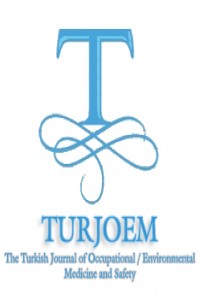THE EFFECT OF MUTATED DNA REPAIR GENES ON DNA DAMAGE IN INDIVIDUALS OCCUPATIONALLY EXPOSED TO ARSENIC
Öz
Investigating
association of variant genotypes of DNA repair enzyms with DNA damages has an
important place on revealing metal toxicity mechanisms. The aim of this study
was to investigate the effect of mutated DNA repair genes on lymphocyte DNA
damage in individuals occupationally exposed to arsenic.
In this study,
X-ray repair cross complementing group 1 (XRCC1) Arg399Gln and X-ray
cross-complementing group 3 (XRCC3) Thr241Met gene polymorphisms were analyzed
by Polymerase Chain Reaction- Restriksiyon Fragment Lenght Polymorphism
(PCR-RFLP) technique to detect individual susceptibility. DNA damages of the
peripheral blood lymphocytes were evaluated according to the alkaline comet
assay parameters including Comet Lenght (CL), Tail Intensity (TI), Tail Lenght
(TL) in 175 individuals ocupationally exposed to arsenic and blood arsenic
level was detected by graphite furnace atomic absorption spectroscopy (GFAAS).
Lymphocyte DNA
damages were found significantly higher in individuals occupationally exposed
to arsenic with XRCC1/XRCC3 homozygote atypical (Gln/Gln; Met/Met) genotypes
than these with homozygote typical (Arg/Arg; Thr/Thr) genotypes and
heterozygote (Arg/Gln;Thr/Met) genotypes (p<0.01). Furthermore, a
statistically significant association was found between blood arsenic level and
DNA repair genes (XRCC1/XRCC3) (p<0.001).
Our study showed
that mutated DNA repair genes (XRCC1/XRCC3) caused much more lymphocyte DNA
damages than homozygote typical and heterozygote genotypes in individuals
occupationally exposed to arsenic.
Anahtar Kelimeler
Kaynakça
- Middle Black Sea Passage Generation of Agricultural Research Institute Director, Tokat, Turkey
- Ankara University, Institute of Forensic Sciences, Ankara, Türkiye
Öz
Kaynakça
- Middle Black Sea Passage Generation of Agricultural Research Institute Director, Tokat, Turkey
- Ankara University, Institute of Forensic Sciences, Ankara, Türkiye
Ayrıntılar
| Bölüm | Articles |
|---|---|
| Yazarlar | |
| Yayımlanma Tarihi | 16 Şubat 2017 |
| Yayımlandığı Sayı | Yıl 2017 Cilt: Volume 2 Sayı: İssue 1 (1) - 2.İnternational Congress Of Forensic Toxicology |


